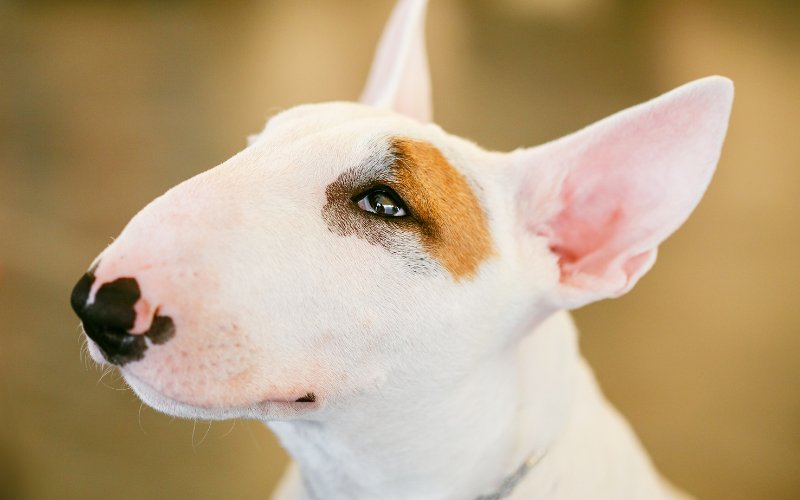
Can Bull Terriers Breathe?
|
Time to read 4 min
|
Time to read 4 min
©Ryhor Bruyeu (Grigory Bruev) via Canva.com
In the world of dog breeds, English Bull Terriers stand out not only for their playful personalities and distinctive egg-shaped heads but also for their unique respiratory characteristics. In this comprehensive guide, we'll delve into the intriguing world of Bull Terrier breathing, exploring how their head shape influences their respiration and what owners can do to ensure their beloved Bull Terriers can breathe comfortably.
One of the first things you notice when you encounter an English Bull Terrier is their unmistakable head shape. This breed boasts an iconic, egg-shaped skull with a downward-facing nose—a feature that sets them apart from other canine companions. This unique head shape not only gives them a one-of-a-kind appearance but also plays a significant role in their breathing patterns.
Bull Terriers have a unique nasal anatomy that sets them apart from both brachycephalic and dolichocephalic breeds. Their nostrils are generally larger and more open, allowing for better airflow. However, their elongated snouts can sometimes create turbulence in the airflow, leading to snoring or snorting sounds.
Additionally, Bull Terriers may have a slightly curved nasal bone, which can affect the shape of their nasal passages. This curvature, while not as extreme as that seen in brachycephalic breeds, can contribute to some degree of respiratory noise and labored breathing, especially in situations that require increased airflow, such as during vigorous exercise or when they are excited.
While Bull Terriers are not as prone to severe respiratory issues as brachycephalic breeds, it's essential for owners to be attentive to their breathing patterns and take measures to ensure their comfort, especially in specific environmental conditions or stressful situations.
While English Bull Terriers are not classified as brachycephalic, like Bulldogs or Pugs, their distinct head shape can present breathing challenges. This is a reminder that breed-specific traits, even when not as extreme as in some other breeds, can still impact a dog's overall respiratory well-being. Understanding and addressing these unique traits is essential for ensuring that Bull Terriers can breathe comfortably and live their best lives.
Due to their unique cranial structure, Bull Terriers may be prone to certain respiratory issues. Owners might notice their pets snoring or experiencing labored breathing at times, especially in hot or humid weather.
While occasional snoring is common among Bull Terriers and many other breeds, it's essential to distinguish between normal snoring and excessive snoring which could be a sign of a more serious issue. Labored breathing, especially during exercise or in stressful situations, may also be a cause for concern.
Bull Terriers may be more sensitive to heat due to their respiratory system. It's essential to be vigilant during hot weather, ensuring your dog stays cool and hydrated. Overheating can exacerbate breathing difficulties, so providing shade, access to fresh water, and limiting strenuous exercise during the hottest parts of the day are crucial precautions. Using cooling vests or mats can help regulate your Bull Terrier's body temperature and reduce the risk of heat-related stress, further enhancing their comfort during warm weather.
Ensuring the health and well-being of your Bull Terrier involves understanding their unique respiratory needs. Regular exercise is crucial for maintaining a healthy weight and overall well-being. Bull Terriers are energetic dogs, but owners should be cautious about excessive exercise during hot weather, as this can exacerbate breathing difficulties.
Temperature regulation is particularly important for Bull Terriers. Due to their head shape, they can be sensitive to heat. Providing shade and access to fresh water, especially during hot days, is essential to prevent overheating and help them breathe comfortably. Using cooling vests or mats can help regulate your Bull Terrier's body temperature and reduce the risk of heat-related stress, further enhancing their comfort during warm weather.
Stress management is another vital aspect of Bull Terrier well-being. Stress can affect their breathing and overall mental health. Creating a calm living environment and employing positive reinforcement techniques can help reduce stress and promote respiratory comfort.
To minimize the risk of breathing problems in your Bull Terrier, consider these preventive measures:
Temperature Control: Ensure your Bull Terrier stays cool during hot weather. Avoid strenuous activities in the heat, and provide a well-ventilated living space.
Regular Exercise: Engage your Bull Terrier in regular, moderate exercise to maintain a healthy weight and promote cardiovascular health.
Stress Reduction: Use positive reinforcement and provide a stress-free living environment to minimize anxiety and its impact on breathing.
Veterinary Check-ups: Schedule regular check-ups with a veterinarian to monitor your dog's respiratory health and address any emerging issues promptly.
In severe cases where Bull Terriers experience significant breathing issues, consult with a veterinarian for guidance. Treatment options may include lifestyle adjustments, medication, or, in rare cases, surgical interventions. Each dog is unique, and a veterinarian can recommend the most suitable approach based on their specific needs. It's crucial to remember that early intervention and expert advice are key to ensuring your Bull Terrier's respiratory health and overall well-being.
Responsible ownership of English Bull Terriers involves being aware of their unique characteristics and needs. While their head shape sets them apart, it's essential to embrace these distinctions and prioritize their well-being. Promoting responsible breeding practices within the Bull Terrier community ensures the long-term health and happiness of these beloved dogs. Remember, by championing responsible ownership, you not only contribute to your dog's well-being but also play a part in preserving the breed's health and vitality for future generations to enjoy.
English Bull Terriers are a distinctive and lovable breed known for their unique head shape and spirited personalities. While their head shape can pose some breathing challenges, responsible ownership, including temperature control, regular exercise, stress management, and veterinary care, can help them breathe comfortably and enjoy a fulfilling life. By understanding and addressing their specific needs, Bull Terrier owners can ensure these remarkable dogs thrive and continue to bring joy to their lives.